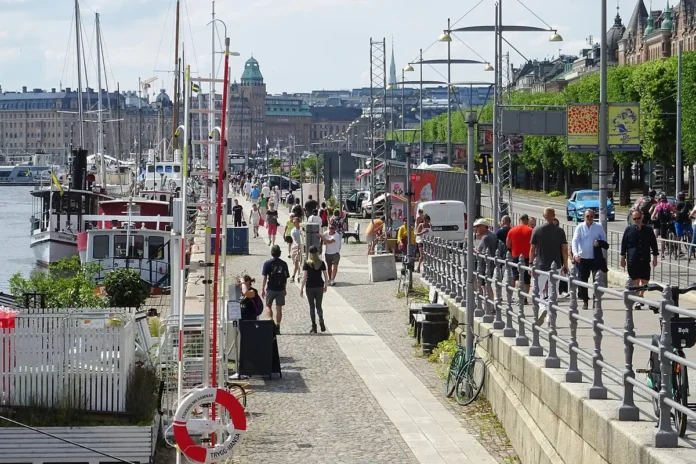Strandvägen: History, architecture, and scenic beauty
Strandvägen, renowned as one of Stockholm’s most prestigious and picturesque boulevards, extends gracefully along the waterfront from Djurgårdsbron bridge to Nybrokajen.
This iconic avenue, constructed in the late 19th century, represents a period of architectural and urban development that transformed it into one of the city’s most desirable addresses. The thoroughfare was meticulously planned and built between 1897 and 1901, coinciding with the significant urbanization phase that saw Stockholm emerging as a modern European capital.
The street perfectly captures the fusion of the past and present. It provides a scenic promenade where visitors can take leisurely strolls. The waterfront setting adds to the boulevard’s charm. It becomes an idyllic spot for reflection and relaxation. Boats gently bob on the water against the serene landscape of Djurgården Island.
A journey through Art Nouveau and Jugendstil
The architectural splendor of Strandvägen is undeniably its most striking feature. The boulevard is lined with an array of grandiose buildings, primarily in the Art Nouveau and Jugendstil styles, which reflect the affluence and ambition of that era. These historical edifices, with their charming facades, intricate detailing, and elegant proportions, offer a visual feast for visitors.
Exploring the attractions along Strandvägen
Strandvägen offers a delightful array of attractions, seamlessly blending culture, history, and modernity. As you stroll along this iconic boulevard, your first stop should be the Royal Dramatic Theatre, also known as Dramaten. Founded in 1788, this historic theater is a cornerstone of Swedish cultural life and features a stunning Art Nouveau design. Many distinguished playwrights and actors, including the world-renowned Ingmar Bergman, have graced its stage.
Adjacent to Dramaten, you’ll encounter a series of historic buildings. These capture the architectural grandeur of the late 19th and early 20th centuries. These structures not only offer a visual treat but also house a variety of high-end residences and offices. This adds to the boulevard’s esteemed reputation. As you continue your walk, the presence of luxury hotels and exclusive boutiques becomes more evident.
The picturesque waterside location of Strandvägen provides visitors an opportunity to soak in magnificent views. Moreover, the serene marina is often dotted with impressive yachts, further accentuating the lavish ambiance. Strandvägen is an excellent destination for those seeking retail therapy. The boulevard is lined with exquisite shops that range from high-end fashion outlets to bespoke jewelry stores, ensuring a unique shopping experience.
Nearby museums and cultural sites
Strandvägen, one of Stockholm’s premier waterfront boulevards, is not only synonymous with scenic beauty and luxury but also serves as a gateway to some of the city’s most celebrated museums and cultural landmarks. Visitors seeking to delve into Sweden’s rich history and vibrant culture will find several noteworthy institutions within easy reach.
The illustrious Vasa Museum, situated on the island of Djurgården, stands as a testament to Sweden’s maritime heritage. At the heart of the museum lies the magnificently preserved 17th-century warship, the Vasa, which sank on its maiden voyage in 1628. The museum offers an immersive experience with tours detailing the ship’s construction, sinking, and subsequent recovery. It is open daily, making it a convenient addition to any itinerary.
The Nordic Museum (Nordiska museet) offers a deep dive into the cultural history of the Nordic countries. Exhibits cover everything from traditional folk art and fashion to contemporary social issues. The museum is situated near Vasamuseet and usually welcomes visitors daily, providing an enriching cultural experience.
Planning your visit
Charting a walking route along Strandvägen can significantly enrich your visit. Starting at Nybroplan and Berzelii Park, strolling along the waterfront towards Djurgården is a popular choice. This route allows you to take in the splendid views of the traditional and contemporary architecture, magnificent yachts, and the serene Baltic waters.
For a delightful meal with a view, Strandvägen offers numerous restaurants and cafes. Establishments such as Strandvägen 1, which combines a sophisticated menu with picturesque surroundings, provide an excellent dining experience.
Other dining options include Villa Godthem and Wärdshuset Ulla Winbladh. Both of these restaurants offer outdoor seating with splendid vistas of Stockholm’s waterfront.
Transportation to and from Strandvägen is hassle-free thanks to Stockholm’s efficient public transport system. Buses and trams have stops conveniently located along the boulevard. Alternatively, renting a bike can provide a more intimate exploration, allowing you to stop and admire the surroundings at your own pace. Moreover, scenic boat tours are another excellent option, offering a unique perspective of Strandvägen from the water.
If capturing stunning photographs is a priority, key locations include the pier near Berzelii Park, where you can capture the entire stretch of Strandvägen, and the Royal Dramatic Theatre for more architectural shots. Insider tips include sunrises at Nybroviken.
Ultimately, you can maximize your day exploring Stockholm’s iconic Strandvägen boulevard by planning ahead, choosing the right times, and understanding the best routes and dining spots.






